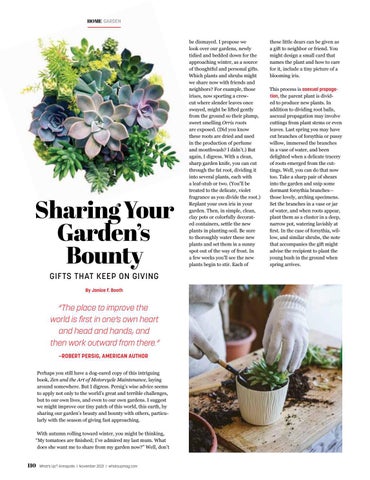HOME GARDEN
Sharing Your Garden’s Bounty GIFTS THAT KEEP ON GIVING By Janice F. Booth
“The place to improve the world is first in one’s own heart and head and hands, and then work outward from there.” —ROBERT PERSIG, AMERICAN AUTHOR Perhaps you still have a dog-eared copy of this intriguing book, Zen and the Art of Motorcycle Maintenance, laying around somewhere. But I digress. Persig’s wise advice seems to apply not only to the world’s great and terrible challenges, but to our own lives, and even to our own gardens. I suggest we might improve our tiny patch of this world, this earth, by sharing our garden’s beauty and bounty with others, particularly with the season of giving fast approaching. With autumn rolling toward winter, you might be thinking, “My tomatoes are finished; I’ve admired my last mum. What does she want me to share from my garden now?” Well, don’t
110
What’s Up? Annapolis | November 2021 | whatsupmag.com
be dismayed. I propose we look over our gardens, newly tidied and bedded down for the approaching winter, as a source of thoughtful and personal gifts. Which plants and shrubs might we share now with friends and neighbors? For example, those irises, now sporting a crewcut where slender leaves once swayed, might be lifted gently from the ground so their plump, sweet smelling Orris roots are exposed. (Did you know these roots are dried and used in the production of perfume and mouthwash? I didn’t.) But again, I digress. With a clean, sharp garden knife, you can cut through the fat root, dividing it into several plants, each with a leaf-stub or two. (You’ll be treated to the delicate, violet fragrance as you divide the root.) Replant your own iris in your garden. Then, in simple, clean, clay pots or colorfully decorated containers, settle the new plants in planting-soil. Be sure to thoroughly water these new plants and set them in a sunny spot out of the way of frost. In a few weeks you’ll see the new plants begin to stir. Each of
these little dears can be given as a gift to neighbor or friend. You might design a small card that names the plant and how to care for it, include a tiny picture of a blooming iris. This process is asexual propagation, the parent plant is divided to produce new plants. In addition to dividing root balls, asexual propagation may involve cuttings from plant stems or even leaves. Last spring you may have cut branches of forsythia or pussy willow, immersed the branches in a vase of water, and been delighted when a delicate tracery of roots emerged from the cuttings. Well, you can do that now too. Take a sharp pair of shears into the garden and snip some dormant forsythia branches— those lovely, arching specimens. Set the branches in a vase or jar of water, and when roots appear, plant them as a cluster in a deep, narrow pot, watering lavishly at first. In the case of forsythia, willow, and similar shrubs, the note that accompanies the gift might advise the recipient to plant the young bush in the ground when spring arrives.
























